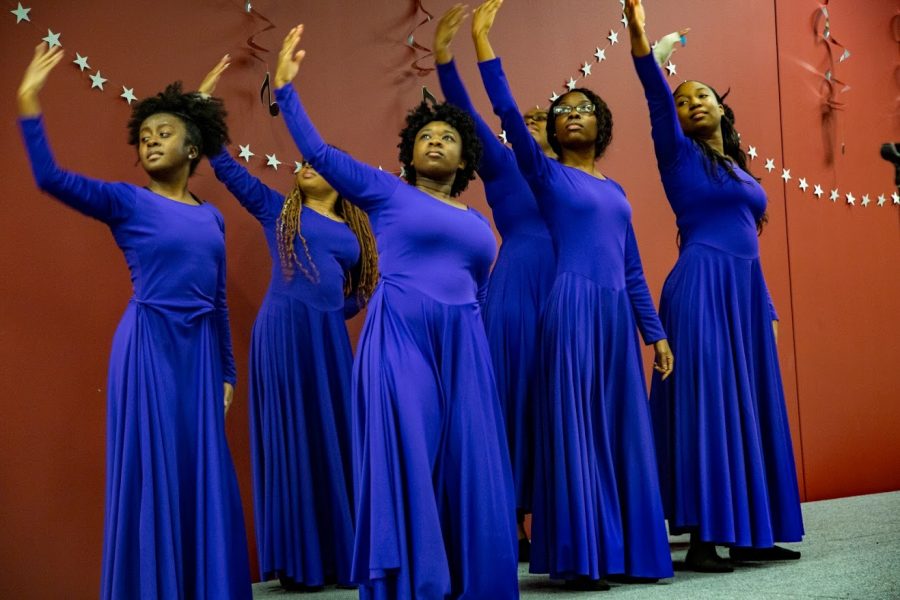University honors Black History Month
ACTS Campus Ministry Praise Dance Team put on a performance at the 10th annual Gospel Explosion at the Student Dining and Residential Programs
February 11, 2019
While February is often considered the month of love by many, it is also Black History Month. It gives time to acknowledge and appreciate African-American heritage.
February offers many celebratory activities and opportunities to learn about the rich history of African-American students on the University campus. One of the men who made a significant impact on the University was named Albert Lee.
Lee was born in 1874 on a farm in Champaign County. He attended local schools and started working in the University president’s office as a messenger at age 20. His career carried on for many years after.
“In one shape or another, he was employed in the president’s office for the next 53 years, and he was the second African-American employed on campus,” said Ryan Ross, coordinator for the History and Traditions Programs at the Illinois Alumni Alliance.
Lee worked under seven University presidents and was the official chief clerk. However, he gained a lasting nickname as the Unofficial Dean of African-American students. He was one of the biggest advocates for African-American students at the time, helping to fund their schooling and aiding them in finding housing using connections from his church, Bethel AME.
Get The Daily Illini in your inbox!
“He was able to use his relationships with people to find housing in people’s homes for African-American students on the north side of Champaign,” Ross said. “African-American students had to live pretty far away from campus, but they at least had places to stay where people were hospitable and accommodating in a time when so many other facets of society weren’t.”
Lee persuaded the University to help fund the purchase of Greek housing on campus, including Kappa Alpha Psi fraternity and Alpha Kappa Alpha sorority. These Greek houses became a hangout area for many black students who were living in a segregated area in Champaign called the North End.
The Chancellor’s Office had a memorial service and erected a new headstone for Lee in the Mount Hope Cemetery in Champaign in August. It is unknown what happened to the original headstone.
The Illinois Department of History made a documentary called “A Home of Their Own” that recorded Lee’s contributions to African-American student’s housing outside of the University.
St. Elmo Brady, who earned his doctorate in chemistry in 1926 and was the first African-American to earn the advanced degree, also made a large impact. Throughout his career, Brady was a chemistry professor at four historically black colleges and universities, including Tuskegee University, Fisk University, Howard University and Tougaloo College. He was also the first African-American to be inducted into chemistry honor society Phi Lambda Upsilon and receive the science honorary Sigma Xi.
Prior to retirement, Brady was the chairman of Tougaloo’s chemistry department. Brady dedicated his career to establishing new chemistry curricula and raising money for the universities where he worked. Some of his works can be found in scholarly articles and magazines.
The University’s School of Chemical Sciences celebrated Brady’s accomplishments at an event at Noyes Laboratory on Tuesday. Jessica Ballard, a visiting faculty archives resident for the University library system, said this was her favorite Black History Month event in her two years working at the University.
“I really found that to be a very interesting and inspiring event to see how diverse the room was as well as to see people affiliated with the other institutions where he worked to be there as well,” Ballard said.
Jameatris Rimkus, the University archives program officer, gave a speech about Brady at the event. “I believe that the St. Elmo Brady presentation went well. I mostly focused on his career along with providing images from his papers,” Rimkus wrote in an email.
Rimkus was able to interview Brady’s granddaughter, Carol Brady Fonvielle, before the School of Chemical Sciences event. Fonvielle donated some of Brady’s belongings for the University’s archive exhibits.
The University was also impacted by a program called Project 500. Rev. Martin Luther King Jr.’s assassination sparked the creation of the Special Educational Opportunities Program, or Project 500. It was an effort to increase enrollment of underrepresented students on college campuses. This program increased the enrollment of black and Latino students from nearly 370 students to over 560 in 1968.
The program backfired, causing the other University students to protest and lead to the arrest of 240 minority students. Jessica Ballard worked on the archives for Project 500 and said this is one of the most pivotal moments for African-American students at the University.
“African-Americans from early on have always had a presence on this campus,” Ballard said. “But, I really wanted to highlight how Project 500 really was a big movement and probably made a big impact. Because that was when you had a very large number of African-Americans that came to campus all at once really sparked a lot of movement with the Afro-American cultural center — now the Bruce D. Nesbitt African American Cultural Center — which also kind of inspired La Casa, which was constructed a few years later after BNAAC.”
Black History Month gives opportunities for campus community members to reflect on the rich history of the fight toward equal rights through meaningful discussions and group dinners, as well as celebrate with Gospel Explosion, lip sync battles, fashion shows and karaoke nights.







